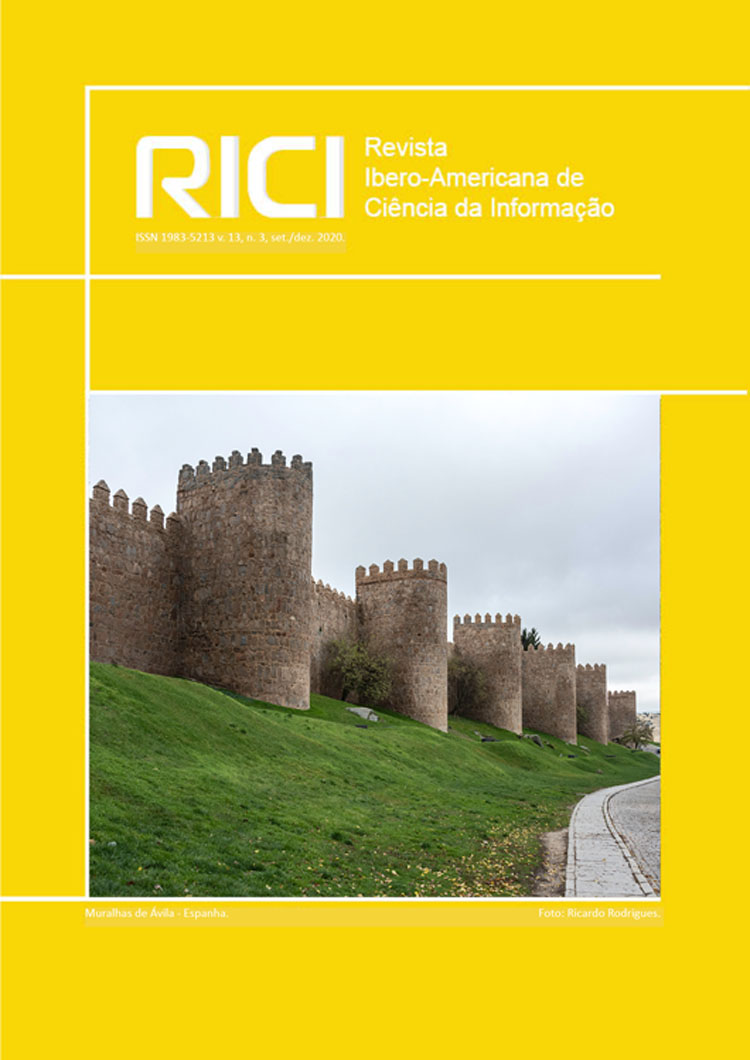Call number: study of practices adopted in Brazilian federal academic libraries practices analysis
DOI:
https://doi.org/10.26512/rici.v13.n3.2020.29758Keywords:
Academic libraries, Call number, BrazilAbstract
The research aimed to analyse the practices used in Brazilian university libraries, identifying the elements used in the construction of the call number, looking for similarities in their choices and ways of using them, as well as adherence with the literature in the area. This is a qualitative descriptive research combined with quantitative, using a questionnaire to collect data, via email, through Google forms. The accidental non-probabilistic sample was used, that is, the 26 libraries that answered the questionnaire were considered, which corresponds to 38,24% of the total of 68 Brazilian federal universities. The responses obtained showed that the composition of the call number is diverse, with reduced convergence in terms of similarities in the practices adopted, as well as some compatibility with the specialized literature in the area, which indicates the need for further studies.
Downloads
References
BARDEN, Bertha R. Book number: a manual for students with a basic code of rules. Chicago: American Library Association, 1937. 31p. Disponível em: <http://babel.hathitrust.org/cgi/pt?id=mdp.39015033787162;view=1up;seq=7 >. Acesso em: 2 mar. 2017.
CARIBÉ, Rita de Cássia do Vale. Notação de autor: sua história. Informação e Sociedade: estudo,. João Pessoa, v. 26, n. 2, p. 121-135, maio/ago. 2016. Disponível em: <http://www.ies.ufpb.br/ojs2/index.php/ies/article/view/28650>. Acesso em: 8 fev. 2017.
CARIBÉ, Rita de Cássia do Vale. Ordenamento de documentos em bibliotecas: tipologia. Informação e Sociedade: estudo,. João Pessoa, v. 29, n. 2, p. 125-144, abr./jun. 2019.
COMAROMI, John Phillip. Book numbers: a historical study and practical guide to their use. Littleton: Libraries Unlimited, 1981. 145p.
CUTTER, Charles Ammi. Another plan for numbering books. Library Journal, New York, v. 3, n. 7, p. 248-251, Sept. 1878.
CUTTER, Charles Ammi. Cutter-Sanborn: three-figure author table. Englewood: Libraries Unlimited, 1969. 36p.
CUTTER, Charles Ammi. Explanação das marcas de autor Cutter-Sanborn: tabelas com três algarismos. Rio de Janeiro: Departamento Administrativo do Serviço Público, Departamento de Imprensa Nacional, 1952.
CUTTER, Charles Ammi. Explanação das marcas de autor Cutter-Sanborn: tabelas com três algarismos. 2.ed. Rio de Janeiro: Departamento Administrativo do Serviço Público, Departamento de Imprensa Nacional, 1962.
GIL, Antônio Carlos. Métodos e técnicas de pesquisa social. 6. ed. São Paulo: Atlas, 2008. 220 p.
JAST, Louis. Stanley. A new book number. The Library World, London, v. 3, n. 5, p. 120-123, 1901.
JAST, Louis. Stanley. A new book number. The Library World, London, v. 3, n. 6, p. 150-152, 1901.
KESSLER, María Inés. El orden de los libros en el estante: un estudio sobre la signatura topográfica en las bibliotecas universitarias de la Universidad Nacional de La Plata. Revista Interamericana de Bibliotecología, Medellin, v. 34, n. 1, p. 49-61, 2011.
LEHNUS, Donald J. Notação de autor: manual para bibliotecas. Rio de Janeiro: BNG/Brasilart, 1978. 83p.
LENTINO, Noêmia. Classificação decimal universal (CDU): seu desenvolvimento, sua atualização. São Paulo: Folco Masucci, 1967. 127p.
LENTINO, Noêmia. Guia teórico, prático e comparado dos sistemas de classificação bibliográfica. São Paulo: Polígono, 1971. 407p.
MALTBY, Arthur. Sayer’s Manual of classification for librarians. London: André Deutsch, 1975. 336p.
MEY, Eliane Serrão Alves. Catalogação e descrição bibliográfica: contribuições a uma teoria. Brasília: ABDF, 1987. 201p.
MEY, Eliane Serrão Alves. Introdução à catalogação. Brasília: Briquet de Lemos, 1995. 123p.
ORTEGA, Cristina Dotta; SILVA, Camila Mariana Aparecida da Silva; SANTOS, Marcelo Nair. Ordenação de documentos na atividade bibliográfica. Brasília: Briquet de Lemos, 2016. 146p.
OSBORN, Jeanne. Dewey Decimal Classification, 19th edition: a study manual. Littleton: Libraries, 1982, 366p.
PINHEIRO, Ana Virgínia. A ordem dos livros na biblioteca. Rio de Janeiro: Interciência, 2007. 66p.
PRADO, Heloisa de Almeida. Organização e administração de bibliotecas. 2.ed. Rio de Janeiro: Livros Técnicos e Científicos, 1979. 221p.
RANGANATHAN, Shiyali Ramamrita. Prolegomena to Library Classification. New York: Asia Publishing House, 1967. Disponível em: <http://arizona.openrepository.com/arizona/handle/10150/106370>. Acesso em: 02 jul. 2011.
RICHARDSON, Roberto Jarry et al. Pesquisa social: métodos e técnicas. 3. ed. São Paulo: Atlas, 1999. 334p.
SLAVIC, Aida. Call numbers, book numbers & collection arrangements in European Library Traditions. In.: SINGH, Jagtar; MALHAN, Indervir; KAUR, Trishanjit (ed). Library & information Science in digital age. Portland: International Specialized Book Service, 2009. 2v. Cap. 25, p. 257-285.
TAYLOR, Arlene G.; JOUDREY, Daniel N. The organization of information. 3.ed. London: Libraries, 2009. 512p.
Downloads
Published
How to Cite
Issue
Section
License
Copyright (c) 2020 Rita de Cassia do Vale Caribé, Ana Izabel da Silva Souza Rocha

This work is licensed under a Creative Commons Attribution 4.0 International License.
Copyright Notice
Authors who publish in this journal agree to the following terms:
- Authors retain copyright and grant the journal right of first publication with the work simultaneously licensed under the Creative Commons Attribution License 4.0, allowing the sharing of work and recognition of the work of authorship and initial publication in this journal.
- Authors are able to take on additional contracts separately, non-exclusive distribution of the version of the paper published in this journal (ex.: distribute to an institutional repository or publish as a book), with an acknowledgment of its initial publication in this journal.
- Authors are permitted and encouraged to distribute their work online (eg.: in institutional repositories or on their website) at any point before or during the editorial process, as it can lead to productive exchanges, as well as increase the impact and citation the published work.
















